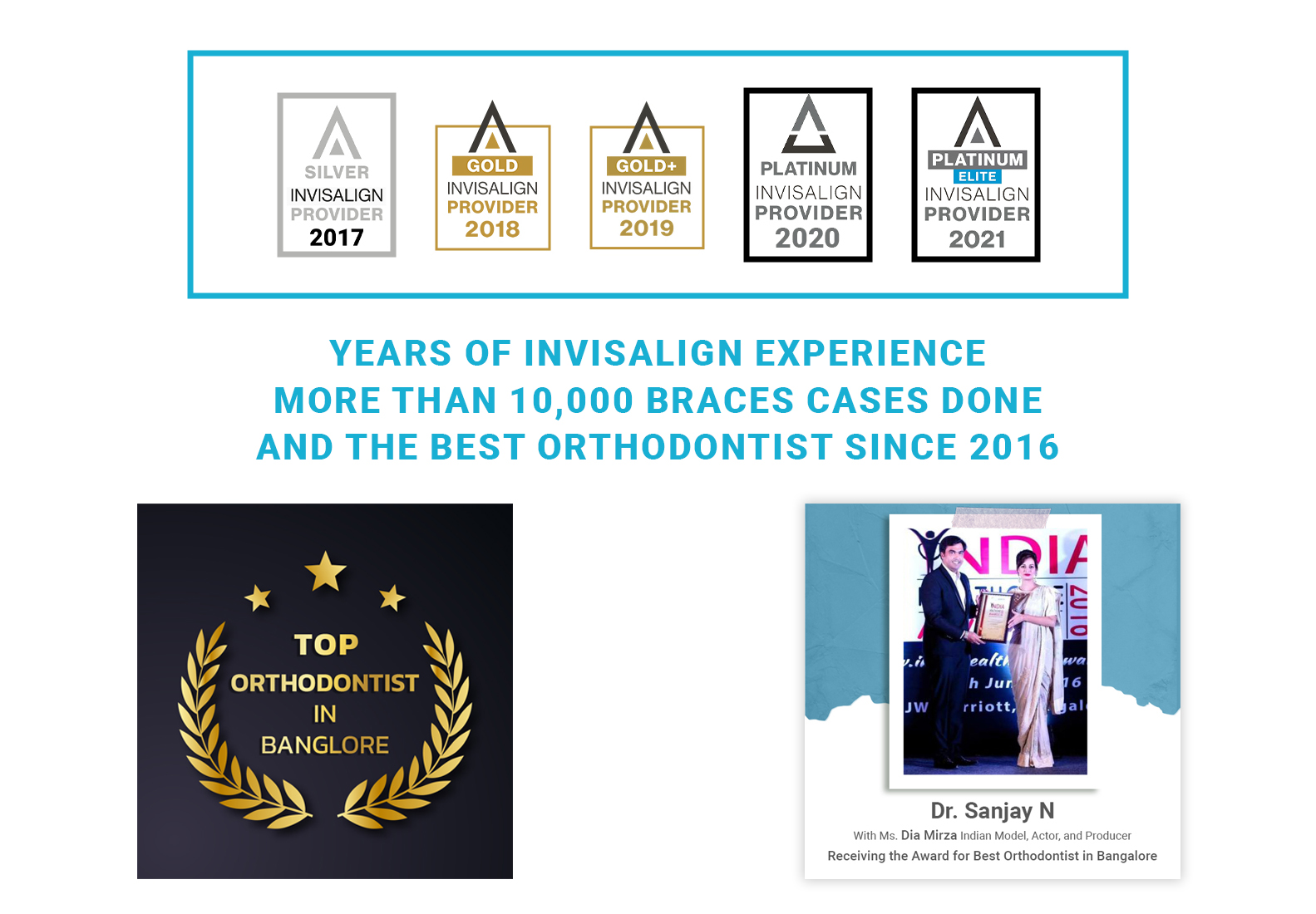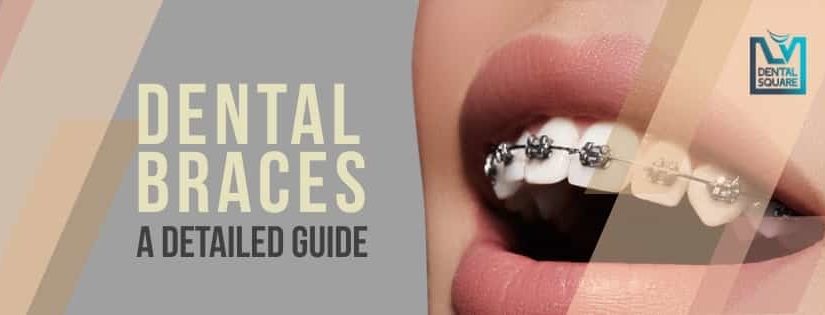
What are dental braces?
Dental braces are wire-based devices or appliances that orthodontists use to place directly on the teeth to straighten them, to correct crowded teeth or to align how our teeth come together between the upper and lower jaws in proportion to a person’s bite. Dental braces are the most common way to achieve optimally aligned teeth.
Dental Braces are classified under the dental specialty of “orthodontics’ which is the branch of dentistry that corrects teeth and jaws that are positioned improperly (malocclusion). Orthodontic treatment with braces is used for functional improvement as well as cosmetic changes with respect to teeth position.
What do dental braces look like?
Dental Braces are made of metal or ceramic, wires, and bonding material that attaches them to the teeth.The traditional dental braces are made of brackets that are bonded to the teeth and a metal wire that is inserted into these brackets. The metal wires are tightened and work together with the brackets to move teeth into the desired positions.
While dental braces are the main components that Orthodontics use for teeth movement improvement, they also have to at times work with one’s facial bone growth to achieve favorable jaw dimensions and relationship.
How dental braces work?
Braces move the teeth by exerting constant pressure on them for over a period of time. As the teeth move, the bone changes shape as pressure is applied. The shape of the jaw gradually adapts to conform to this pressure.
Braces are made up of the following components:
- Brackets – Small squares that are sometimes bonded directly to the front of each tooth with a special dental bonding agent or are attached to orthodontic bands or occasionally cemented to the back of the teeth in order to hide them from viewing. Brackets hold the arch wires that move the teeth and act like handles. There are several types of brackets, including stainless steel and tooth-colored ceramic or plastic, which are now a go-to option because they’re less obvious.
- Orthodontic bands – These are the anchors to the brackets. They are made of stainless steel or clear plastic material, or tooth-colored materials that are cemented to the teeth with dental bonding agents. These bands are wrapped around each tooth to hold them tight. These bands are not necessarily used in all patients, for some only brackets are used.
- Spacers – Prior to placing the orthodontic bands, separators are added to fit between teeth to create a small space.
- Arch wires – These arch wires connect all the brackets and the band and controls the movement of the teeth. Arch wires can be clear, tooth coloured or made of metal.
- Ties – Small fine wires or rubber rings that fasten the arch wire to the brackets. They can be coloured, clear or made from metal.
- A buccal tube – a metal tube fixed to the facial (buccal) surface of an orthodontic molar band or directly to the surface of the tooth which allows the archwire to pass through while applying either a torquing force or allowing the wire to slide as tooth movement occurs.
- Tiny elastic rubber bands – Also called ligatures, hold the arch wires to the brackets.
- Springs – These are placed on the arch wires between brackets to push, pull, open, or close the spaces between the teeth.
- Elastics or rubber bands – These are attached to hooks on brackets and are worn between the upper and lower teeth in various ways. They apply pressure to move the upper teeth against the lower teeth, this helps achieve the perfect fit for each tooth.
- Facebow headgear – The facebow consists of an inner metal part shaped like a horseshoe that goes in the mouth, attaching to buccal tubes, and an outer part that goes around the outside of the face and is connected to a headgear strap. This gadget is used to move the upper molars back in the mouth to correct bite discrepancies and also to create room for crowded teeth.
Although these components are more appropriate to the traditional metal and ceramic braces, newer methods of using removable plastic retainers may also work when crowding of the teeth is not too severe. You can discuss the options with your orthodontist and s/he can list the various options of braces with you and determine which might be the best option for your situation.
What are the types of dental braces?
Today, dental braces in bangalore come in all sizes and shapes – this is one good news for a lot of patients out there as traditional metal braces are not the only choice. Choosing the one that fits your condition depends on various considerations such as aesthetics, cost, and other related concerns.
Here are some of the most popular types of dental braces in bangalore that are offered at LV Dental Square.
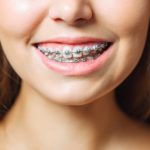 Metal wired braces: These are the most common and traditional type of braces. They are made from a high-grade stainless steel and have metal brackets that are attached to each tooth using a type of cement. Metal brackets are fixed (bonded) onto the teeth and secure a wire with elastic ties made out of rubber which puts pressure on the teeth to cause them to move slowly into the correct position.
Metal wired braces: These are the most common and traditional type of braces. They are made from a high-grade stainless steel and have metal brackets that are attached to each tooth using a type of cement. Metal brackets are fixed (bonded) onto the teeth and secure a wire with elastic ties made out of rubber which puts pressure on the teeth to cause them to move slowly into the correct position.
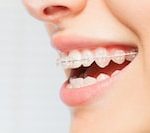 Ceramic wired braces: Also known as clear braces, these dental braces work in the same way as traditional braces, but the brackets are made from transparent, clear ceramic material. These are a cosmetic alternative to the metal wired braces as they are less visible compared to metal braces. The disadvantage of wearing ceramic braces is that they are more prone to breakage when compared to the metal braces.
Ceramic wired braces: Also known as clear braces, these dental braces work in the same way as traditional braces, but the brackets are made from transparent, clear ceramic material. These are a cosmetic alternative to the metal wired braces as they are less visible compared to metal braces. The disadvantage of wearing ceramic braces is that they are more prone to breakage when compared to the metal braces.
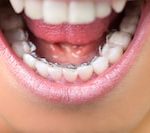 Lingual braces: The name says it all. The Lingual dental braces are braces that are attached to the lingual (on the side towards the tongue) of the teeth and are not obviously visible. The time taken to complete the treatment is longer.
Lingual braces: The name says it all. The Lingual dental braces are braces that are attached to the lingual (on the side towards the tongue) of the teeth and are not obviously visible. The time taken to complete the treatment is longer.
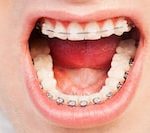 Damon Braces: These are self-ligating dental braces that are fixed in the same way as traditional metal braces. The difference – instead of having brackets that tighten and adjust the braces regularly, Damon braces uses a slide mechanism that attaches wires to brackets to move naturally with the teeth as they realign. This helps provide strong results in a shorter time and requires fewer dental visits. The cost attached to Damon braces is also reasonable.
Damon Braces: These are self-ligating dental braces that are fixed in the same way as traditional metal braces. The difference – instead of having brackets that tighten and adjust the braces regularly, Damon braces uses a slide mechanism that attaches wires to brackets to move naturally with the teeth as they realign. This helps provide strong results in a shorter time and requires fewer dental visits. The cost attached to Damon braces is also reasonable.
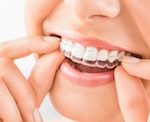 Invisalign aligners: Invisalign® is a type of clear aligner.They are dental braces that help to straighten your teeth except they are not seen – Invisible. Invisalign® tosses out the use of brackets, metal wires, etc and uses clear, medical-grade plastic aligners in its place.
Invisalign aligners: Invisalign® is a type of clear aligner.They are dental braces that help to straighten your teeth except they are not seen – Invisible. Invisalign® tosses out the use of brackets, metal wires, etc and uses clear, medical-grade plastic aligners in its place.
Invisalign clear aligners are made from BPA-free plastic – basically made of a thermoplastic material which is flexible plastic, specially created for the manufacturing of these aligners.
The clear aligners are super comfortable as they are removable. They need to be worn for approximately 20-22 hours a day. The aligners will be changed roughly every two weeks for a period of six to eighteen months, or longer depending on the severity of misalignment.
How much is the cost of Dental braces in Bangalore?
Cost of Dental Braces in bangalore starts from Rs 18,000 for metal braces and goes up with type and quality of braces. While traditional metal and ceramic braces cost less, dental braces like Invisalign are more expensive. Check the table below for costs of dental braces in Bangalore
|
Braces type |
Price range (in Rupees) |
|
Metal braces – Basic Indian type |
18,000 – 22,000 |
|
Metal braces – 3M |
₹26,000 – ₹30,000 |
|
Metal braces – Self-ligating |
₹38,000 – ₹42,000 |
|
Metal braces – Damon self-ligating |
₹58,000 – ₹62,000 |
|
Ceramic braces – Indian type |
₹30,000 – ₹34,000 |
|
Ceramic braces – Monocrystalline |
₹43,000 – ₹47,000 |
|
Ceramic braces – 3M |
₹63,000 – ₹67,000 |
|
Ceramic braces – Damon self-ligating |
₹88,000 – ₹92,000 |
|
lingual braces |
₹1,28,000 – ₹1,32,00 |
|
Clear Aligners – K line |
₹70,000 – ₹1,52,000 |
|
Clear Aligners – Invisalign |
₹75,000 – ₹3,50,000 |
What is a good age for dental braces?
Dental Braces treatment can be beneficial at nearly any age. Although an ideal time for placement of dental braces is between 10 and 14 years of age, this is because the head and mouth are still growing and teeth are more conducive to straightening between this age, unlike adults where the bones are no longer growing. But with the advancement in medical technology and easier and less painful methods of orthodontic treatment available in India, more and more adults are also wearing braces to correct minor problems and to improve their aesthetic and appearance.
Which type of dental braces are best?
Invisible braces are a popular choice among people seeking to fix their teeth alignment. Invisalign offers patients highly effective correction while being virtually unnoticeable. Although a popular choice, not everyone is a perfect fit for this. If braces are indeed the solution for you, the orthodontist will prescribe an appliance specific according to your condition. The braces may be metal braces, ceramic or clear aligners. One method does not work for everyone.
How long does it take for the teeth to move with dental braces?
There are various factors involved – the severity of the problem; the distance the teeth must travel; the amount of room available; the health of the gums, teeth, the supporting bone; and most importantly how closely the patient follows instructions.
On average, once the dental braces are put on, they usually remain in place for one to three years, again depending on the severity and also the type of dental braces being used. After braces are removed, most patients need to wear a retainer all the time for the first six months, and then consult the dentist for further instructions.
How to maintain your dental braces
- Brush and floss regularly: A toothbrush can remove debris from teeth and braces. Food and plaque can get trapped between your braces and your teeth. If you don’t brush and floss it daily, it can cause cavities and even stain your teeth. Floss under the wires of your braces
- Brush in between your brackets: An interdental toothbrush can clean spaces between teeth and braces wires. Use an interdental toothbrush to clean the spaces between the metal and your teeth.
- Visit your orthodontist regularly: Make sure to visit your orthodontist for regular follow-ups, not just for adjustments, but also for cleaning and other oral routine.
What to eat after dental braces?
After getting dental braces, your mouth may become sensitive, therefore, eating foods that have a tougher texture could cause pain.You’ll also have to learn to chew differently and your orthodontist will recommend eating soft foods during the initial days.Going forward, the foods that you can eat with braces are:
Foods you CAN eat with dental braces:
- Dairy products – yogurts, cottage cheese, eggs
- Soft breads – pancakes, muffins but without nuts
- Soft cooked rice
- Vegetables – mashed potatoes, steamed veggies, beans
- Fruits – applesauce, bananas, fruit juice, smoothies, berries
- Ice cream without nuts, milkshakes, soft brownies, soft cookies.
But remember to always limit your intake on sugar!
Foods to avoid with dental braces:
- Chewy foods – Gums, pizza crust
- Crunchy foods – popcorn, chips,
- Sticky foods – caramel candies, gummy candies
- Hard foods – nuts
- Foods that require biting into – corn on the cob, carrots,
Are there any side effects for Dental Braces
Wearing dental braces is generally a very safe procedure. However, there are some risks involved:
Short-term risks
Since braces are prone to create tiny spaces around your teeth, it can trap food particles and promote bacteria-filled plaque deposits. Failure to remove deposits of food and plaque can lead to whitish stains on your teeth or cause tooth decay (cavities) and gum disease
Long-term risks
- Shorter root lengths. During tooth movement, some of the bone in the path of the moving tooth dissolves, while new bone is laid behind it. Permanent loss of tooth root length may occur during this process, which could lead to less stable teeth. In most cases, however, this doesn’t cause any problems.
- Loss of correction. If you don’t follow your orthodontist’s instructions carefully after your braces are removed, particularly when it comes to wearing a retainer, you may lose some of the correction gained while wearing your braces.
Will dental braces be painful?
One of the most commonly asked questions about braces is whether dental braces are painful? The answer is NO! Braces do not hurt at all when they are applied to the teeth. But there will be mild discomfort and soreness after the orthodontic wire is engaged into the brackets, which may last for a few days to a week. Some patients experience discomfort during the first 4 days to a week after their braces are placed. Your mouth will need one to two weeks to get used to the braces.Typically, this pain can be managed with over-the-counter pain relievers. Consume soft, no-chew foods for the first week, such as soup, yogurt, and ice cream.
How often do I need to visit an orthodontist for dental braces?
You must visit your orthodontist at least once a month after you have placed your dental braces as to make sure the braces are working well and exerting steady pressure on the teeth. The orthodontist will also have to make some adjustments in the wires and bands of the braces.
Precautions to take after removing dental braces
The removal of braces may sound like a job-all-done, but no – once braces are taken off, more records – molds and X-rays – are taken to evaluate the end result. And before we get into the Precautions to take after removing dental braces, here are a few things to expect after your braces are removed.
- Due to exposed enamel, your teeth may be a bit sensitive for a few days or a few weeks after the braces are removed.
- As tempting as it might be to binge on chips and other crunchy food, stay back and do not consume these as your teeth are still sensitive and adjusting to the new positions.
Now the most important part – We know that having your teeth straight is a great feeling, and we definitely want you to keep it that way. Hence, after your braces are removed, your orthodontist will also fit you with a retainer – a custom-made, removable or fixed appliance that helps teeth maintain its new position.The use of a retainer is a very important part of post-braces care and is recommended to be worn for a considerable amount of time, although the time frame for wearing a retainer will vary from patient to patient.
You may see some minor shifting of your teeth after the removal of your braces, but the retainer will prevent your teeth from shifting back to where they were.
L V Dental Square is among the top dental clinics in Bangalore offering complete dental services. We offer various types of Dental Braces. Book an appointment to consult the best dental braces clinic in Bangalore.

Dr. Sanjay N is one among the few best Orthodontists in Bangalore who specialises in Invisalign (invisible braces), Damon Braces, and Ceramic braces, and Lingual Braces. He is a keen academician and servers as an Associate Professor at Rajiv Gandhi Dental College & Hospital, Hebbal has been training Post Graduate dental Aspirants in orthodontics since past decade and has has 4 International and 10 National Publications to his credit. Dr. Sanjay has been awarded as the “Best Orthodontist in Bangalore” at the Healthcare Awards in 2016.

